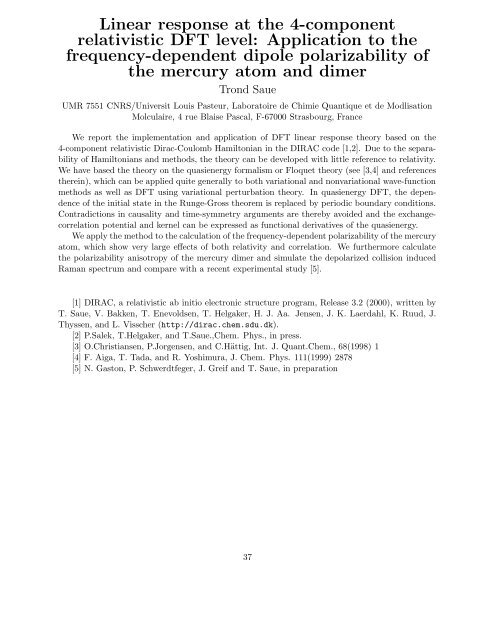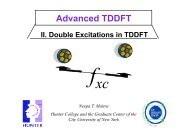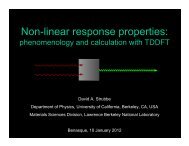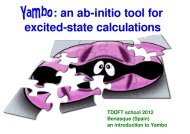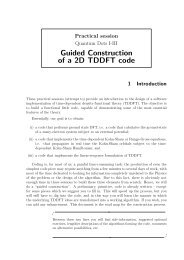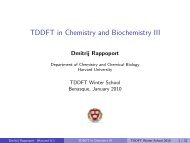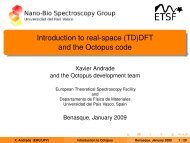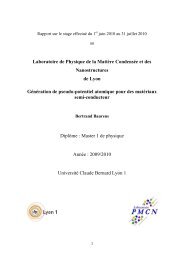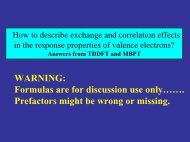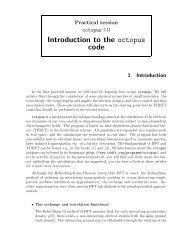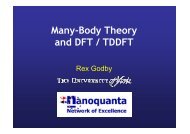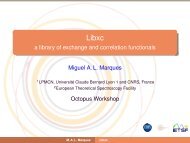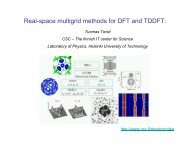TIME DEPENDENT DENSITY FUNCTIONAL THEORY ... - TDDFT.org
TIME DEPENDENT DENSITY FUNCTIONAL THEORY ... - TDDFT.org
TIME DEPENDENT DENSITY FUNCTIONAL THEORY ... - TDDFT.org
- No tags were found...
Create successful ePaper yourself
Turn your PDF publications into a flip-book with our unique Google optimized e-Paper software.
Linear response at the 4-component<br />
relativistic DFT level: Application to the<br />
frequency-dependent dipole polarizability of<br />
the mercury atom and dimer<br />
Trond Saue<br />
UMR 7551 CNRS/Universit Louis Pasteur, Laboratoire de Chimie Quantique et de Modlisation<br />
Molculaire, 4 rue Blaise Pascal, F-67000 Strasbourg, France<br />
We report the implementation and application of DFT linear response theory based on the<br />
4-component relativistic Dirac-Coulomb Hamiltonian in the DIRAC code [1,2]. Due to the separability<br />
of Hamiltonians and methods, the theory can be developed with little reference to relativity.<br />
We have based the theory on the quasienergy formalism or Floquet theory (see [3,4] and references<br />
therein), which can be applied quite generally to both variational and nonvariational wave-function<br />
methods as well as DFT using variational perturbation theory. In quasienergy DFT, the dependence<br />
of the initial state in the Runge-Gross theorem is replaced by periodic boundary conditions.<br />
Contradictions in causality and time-symmetry arguments are thereby avoided and the exchangecorrelation<br />
potential and kernel can be expressed as functional derivatives of the quasienergy.<br />
We apply the method to the calculation of the frequency-dependent polarizability of the mercury<br />
atom, which show very large effects of both relativity and correlation. We furthermore calculate<br />
the polarizability anisotropy of the mercury dimer and simulate the depolarized collision induced<br />
Raman spectrum and compare with a recent experimental study [5].<br />
[1] DIRAC, a relativistic ab initio electronic structure program, Release 3.2 (2000), written by<br />
T. Saue, V. Bakken, T. Enevoldsen, T. Helgaker, H. J. Aa. Jensen, J. K. Laerdahl, K. Ruud, J.<br />
Thyssen, and L. Visscher (http://dirac.chem.sdu.dk).<br />
[2] P.Salek, T.Helgaker, and T.Saue.,Chem. Phys., in press.<br />
[3] O.Christiansen, P.J<strong>org</strong>ensen, and C.Hättig, Int. J. Quant.Chem., 68(1998) 1<br />
[4] F. Aiga, T. Tada, and R. Yoshimura, J. Chem. Phys. 111(1999) 2878<br />
[5] N. Gaston, P. Schwerdtfeger, J. Greif and T. Saue, in preparation<br />
37


